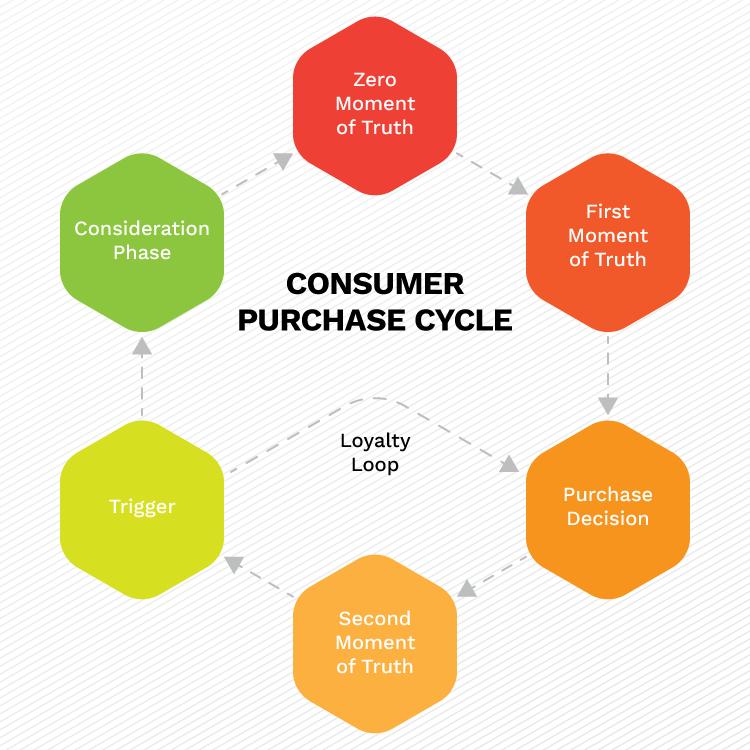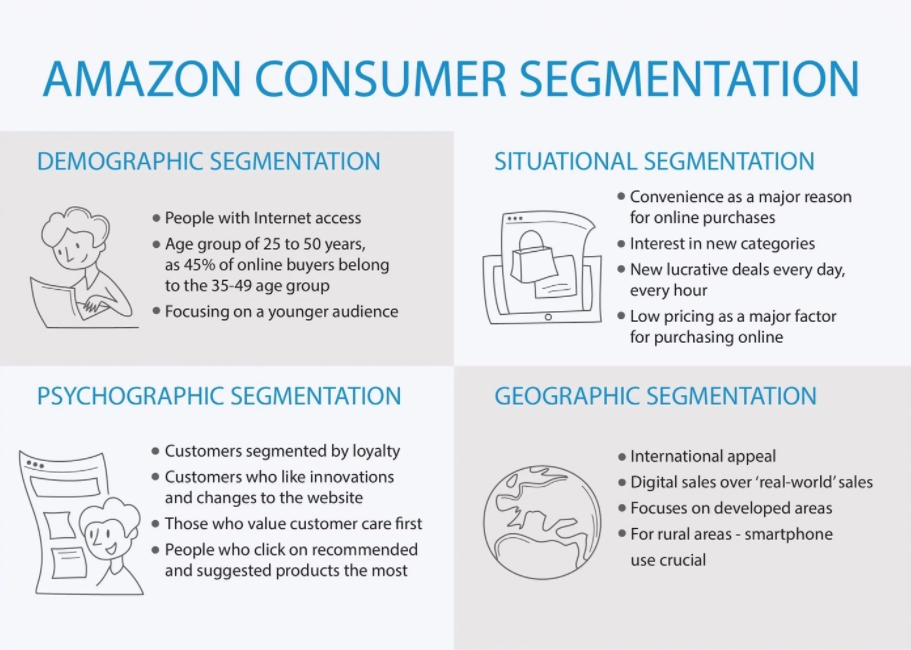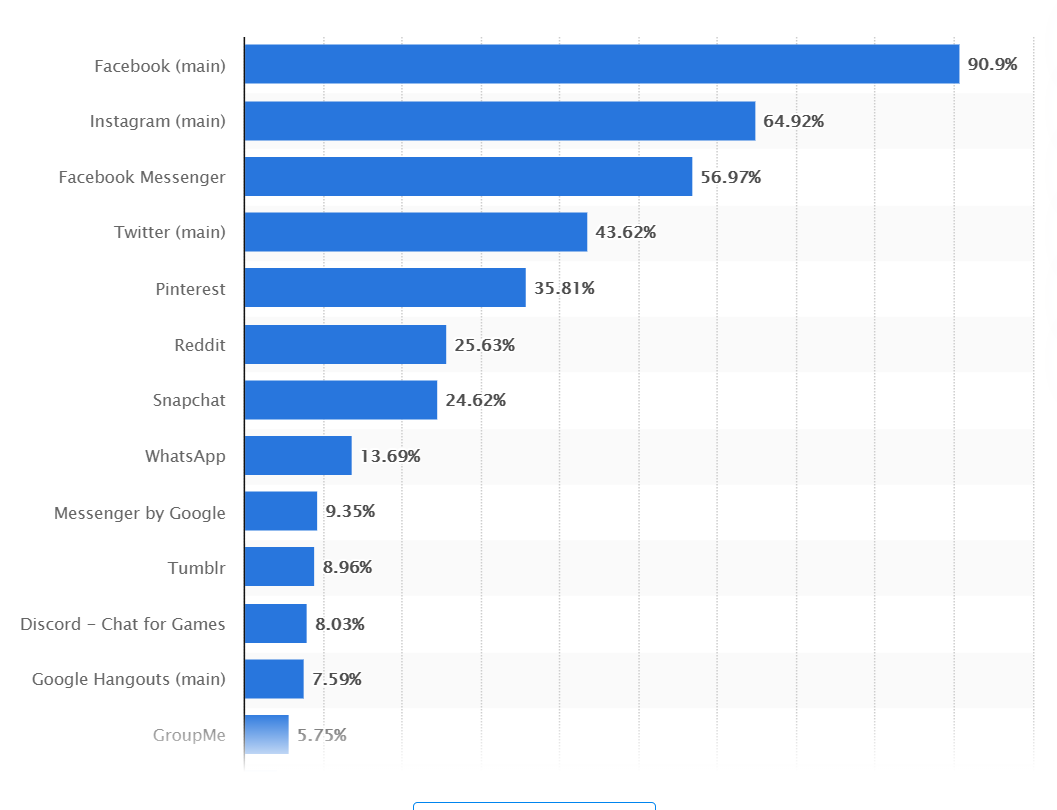Summary of Amazon’s Background and Issues
Since its establishment in 1997, Amazon has focused on e-commerce, which is the practice of selling goods online (Majed et al., 2018). Initially, this company’s goal was to sell books online through its website, and with time, Amazon became a popular shopping destination where consumers can find any type of product they want. Currently, this platform is the largest online shopping resource in the United States (Statista, 2021). This paper will summarize Amazon’s current marketing strategy, the issues that arise as a result of it, and the potential ways of addressing these problems, which will be presented in the form of recommendations at the end of this paper.
Perhaps one issue that Amazon is facing from the viewpoint of its digital strategy is the fact that this is a large business, which incorporates several sectors apart from e-commerce, and its e-commerce platform allows sellers to advertise their products to consumers directly. Hence, it may be difficult to create a unified strategy where all of the products and offers that Amazon has been advertised to the consumers. Majer et al. (2018) argue that Amazon strives to become a customer-centered platform, which is why it uses Big Data and analytics to create a customized experience for its visitors. However, the company may fail to balance its unified promotion and brand strategy when striving to deliver a unique experience for all of its users.
Another issue that Amazon faces is smaller platforms trying to challenge its market position. According to Waters (2020), some of the sellers that previously used Amazon as their platform for connecting with customers are now launching their platforms, especially the ones that produce handcrafted or unique products at a non-mass production scale. Some examples include Shop Where I Live, which is a platform that shows customers local businesses around them. Waters (2020) states that for Amazon, retaining partners who sell on their platform has become an issue due to the many restrictions and regulations that this platform has, which is why crafted product makers often chose to leave Amazon, which may affect the customers’ loyalty towards this platform.
Table 1 is a SWOT analysis of Amazon’s primary activities and issues. The main strengths for Amazon are its market share size, which is at 47% in 2017 according to Statista (2021) and is projected to reach 50% by the end of 2021. During the pandemic, Amazon’s revenue has increased substantially due to many people choosing online shopping as their only option for receiving goods (Walters, 2020). Additionally, considering that Amazon has been operating since 1997 as an e-commerce platform, it has an established brand image and a well-developed network of suppliers and partners. Amazon’s primary market is the United States, which is where this organization was established.
The current number of internet users in the United States is 87%, as stated by the World Bank (2019), which means that this is a lucrative market for an online commerce platform. However, Amazon has also invested in opening subsidiaries and online shopping platforms around the globe. Moreover, considering the opportunities that e-commerce brings to businesses and a large number of Internet users, other businesses can invest in developing their platforms for selling goods, which is a significant threat for Amazon. Therefore, the focus of this company’s strategy should be on creating an excellent brand image and on enhancing the loyalty of its existing consumers to ensure that they select Amazon over competing platforms for their purchases.
Table 1. Amazon’s SWOT (created by the author).
Amazon’s Social Media Strategy
The importance of social media for businesses has increased in recent years with the growing popularity of these media-sharing platforms. Jin et al. (2019) note that the use of social media and partnerships with social media influences have become integral for modern-day marketing. Moreover, the findings of the study by Jin et al. (2019, p. 50) reveal that “consumers exposed to Instagram celebrity’s brand posts perceive the source to be more trustworthy, show a more positive attitude toward the endorsed brand, feel the stronger social presence and feel more envious of the source.” Being a large company, Amazon comprehends the importance of social media marketing and therefore conducts in-house research to determine the expectations of the customers and the potential direction for its social media marketing (SMM) strategy.
Table 2 is the POST strategy that can help companies comprehend the specifics of applying the SMM strategies towards their business objectives, which was developed by Frost (2007). The goal of this approach is to create an optimal and customized experience for users and engage new customers from social media platforms while leveraging the benefits of influencer marketing, which should help Amazon create a better brand image.
Table 2. POST framework (created by the author).
Next, figure 1 illustrates the current trends and direction of the development of the social media landscape in the United States. As Jin et al. (2019) note, influencer marketing is on the rise, and partnerships with the celebrities who have gained their popularity online are providing businesses with more return on their marketing investment when compared to their other marketing expenditures. Moreover, the increasing popularity of video sharing, for example, through TikTok, is providing brands such as Amazon with a plethora of opportunities for reaching the target audience of Millennials and Gen Z.

Amazon’s E-Business and E-Commerce Marketing
In terms of how Amazon market’s its e-commerce platform, the focus is on creating a user-centered experience. Majed et al. (2018) argue that Amazon’s approach to operations is customer-centric, where the company is investigating the consumer trends and customer’s requests and invests in services that would address these needs. Hence, Amazon’s success is linked to the company’s focus on what the consumer wants and on delivering the best shopping experience the company can. The latter is achieved through Amazon’s diverse network of delivery centers from where the customer’s parcels are delivered. Moreover, the customer-centered focus is also a part of the Amazon “your store” option, where the front page of the website is customized for each visitor based on the data about their previous purchases or searches.
Amazon already has an established direction for the development of its e-commerce marketing strategy. According to Majed et al. (2018, p. 65), Amazon currently strives “to become the best place to buy, find and discover any product or service available online.” Hence, the goal of the company’s digital and e-commerce strategy is to become the “go-to” shopping space online for the customers in its primary market, which is the United States, and globally. However, this approach requires special attention to the customer experience and towards ensuring that this experience is satisfactory from the consumers’ viewpoint. This can be achieved by leveraging the reach, act, convert cycle described by Chaffey (2015). Additionally, Picture 1 below illustrates the consumer purchasing loop, where loyalty is achieved after the decision to make a second purchase. Hence, Amazon’s efforts should be focused on engaging consumers in the second and third-time purchases.

In terms of the marketing strategy, Amazon has several goals summarized by Majed et al. (2018) as enhancing customer loyalty, strengthening the brand name, and encouraging repeated purchases. However, with this, one should consider the issue of maintaining high levels of customer satisfaction as another point of concern, especially considering Amazon’s focus on customer loyalty.
Moreover, According to Althafairi et al. (2019, p. 10), Amazon aims to “offer state shipping service, and they have many retail stores in different countries. It also purchases customer data and information to achieve customer needs and wants.” Hence, a lot of focus of this business goes towards achieving high levels of customer satisfaction, yet according to data from Statista, the current levels of customer satisfaction are at 77%, based on 2020 data, while in 2018, they were estimated at 88% (Coppola, 2020). Therefore, despite customer satisfaction being a priority for Amazon and its marketing strategy, the company is experiencing problems with maintaining it and enhancing the level of consumers’ satisfaction with this e-commerce platform.
M-Commerce and Mobile Marketing
Mobile commerce is a growing economic sector that Amazon already has a share of. However, this economic sector is rapidly developing, which requires Amazon to pay specific attention to acquiring customers who shop through mobile applications. According to the Pew Research Center (2020), 97% of Americans use mobile devices in their daily lives, including the use of these devices to make purchases. Hence, approximately every citizen over the age of 18 uses their smartphones, which creates a substantial market reach opportunity for Amazon. The company’s website is well-optimized for use from mobile devices, which contributes to the purchases done through this method.
According to data by Statista (2021), the majority of purchases on Amazon are still completed via desktops and not mobile phones, as demonstrated in Figure 5. Hence, the company should focus on marketing its products on applications that are used by smartphone users, including social media (Jin et al., 2019). In this way, the company will increase its reach towards the consumers who use smartphones.
Moreover, this statistic also suggests that a small percentage of users choose Amazon’s application when purchasing, which requires the company to review the application’s design and usability. Using the consumer purchasing cycle from Picture 1, Amazon can address the factor of “trigger” that initiates the consumer’s decision towards considering a potential purchase. This can be achieved by advertising the application and by providing additional benefits to users who purchase from this source.

Customer Relationship Management
Traditionally, businesses use CRM systems to manage their relationships with customers and maintain brand loyalty. These systems allow to the collection, store, and use of the information pertaining to the consumers’ past purchases and website searches or complaints.
Moreover, Amazon uses this data to create a consumer-centered experience. Picture 1 shows the wide variety of consumer groups who use Amazon’s services, which creates a challenge of developing a CRM system that would allow providing a high-quality service for all groups. Majer et al. (2018) argue that currently, Amazon’s main focus with customer relationship management is the rate of repurchasing. By using the RACE marketing model introduced by Chaffey (2015), Amazon can enhance its CRM management practices. This model is demonstrated below in Figure 6, and this model allows understanding the key marketing indicators that will aid Amazon in increasing its customer loyalty.


Recommendations
Amazon might develop its social media presence, marketing of its e-commerce activity, and its customer relationship management (CRM) further by investing in the enhancement of its customer-centric practices. The main recommendation, considering the analysis above, is to focus on SMM and engaging new customers through influencer marketing. Additionally, it is evident that Amazon faces the issue of decreasing customer satisfaction, and considering this business’ focus on data, as noted by Jin et al. (2019), the company should use social media resources to communicate with the dissatisfied consumers and to increase their loyalty. The recommendations based on the findings of this report can be summarized as the following:
- Amazon should pay more attention to the partnerships with the social media influencers and should relaunch its SMM strategy with a focus on influencer marketing (Jin et al., 2019)
- Amazon should leverage the most popular platforms in the United States: Facebook, Instagram, Twitter, and YouTube, as shown in Figure 2.
- ROPO and SOSTAC models can help Amazon enhance its customer engagement and customer satisfaction levels
- Amazon should focus on M-Marketing by using messenger applications advertisements since, as shown in Figure 2, messengers are also very popular among the United States internet users
- Amazon has to review its CRM management strategy and leverage its data collection infrastructure and Big Data analysis systems to address decreasing customer satisfaction levels
- Amazon should connect with its customers through social media and messengers when addressing customer complaints to enhance loyalty, satisfaction and improve its brand image
- The company should redesign its mobile application using the consumer purchasing cycle map to create more triggers that would prompt potential customers to use the mobile application since 97% of Americans use mobile devices daily (Pew Research Center, 2020)

Conclusion
In summary, this paper reviewed the issues and the current marketing position of Amazon, which is the largest e-commerce platform in the United States. While the pandemic has been beneficial for this business’ development, the decreasing levels of customer satisfaction and the rise of competing platforms, especially for handmade and crafted goods, is a concern. Hence, the nature of products that Amazon sells and, therefore, the customers’ view of this business is changing.
The biggest concern identified in this paper is the issue of satisfaction and Amazon’s need to enhance brand loyalty, which would contribute to the consumer’s decision to repurchase products from this platform. With any new strategy, it is important to also develop measures that would help understand whether the execution has been successful or not. The most appropriate strategy for Amazon to measure the success of the new strategy is to focus on the customer satisfaction metric and the number of new consumers that this platform has after the launch of this new strategy. These metrics, collected through a CRM system, can help understand whether the suggested approach has contributed to the improvement of the identified metrics, the loyalty, repurchasing rates, and satisfaction with the services of Amazon’s e-commerce platform.
Reference list
Amazon consumer segmentation. (no date). Web.
Althafairi, B. et al. (2019) ‘Case study – Amazon’. Journal of the Community Development in Asia(JCDA), 2(2). Web.
Chaffey D. (2015) E-business and e-commerce management. Pearson Education Limited.
Coppola, D. (2020) U.S. customer satisfaction with Amazon.com from 2000 to 2020. Web.
Jin, S.V., Muqaddam, A. and Ryu, E. (2019), ‘Instafamous and social media influencer marketing’, Marketing Intelligence & Planning, 37(5), pp. 567-579. Web.
Majed, S., Nuraddin, S. and Hama, S. (2018) ‘Analyzing the Amazon success strategies’, Journal of Process Management. New Technologies, 6(4), pp. 65-69. Web.
Pew Research Center (2020) Mobile fact sheet. Web.
Statista (2021) Projected retail e-commerce GMV share of Amazon in the United States from 2016 to 2021. Web.
Statista (2019) Top U.S. social media apps by reach 2019. Web.
Waters, M. (2020) Local e-commerce platforms are trying to challenge Amazon. Web.
World Bank (2020) United States of America. Web.
